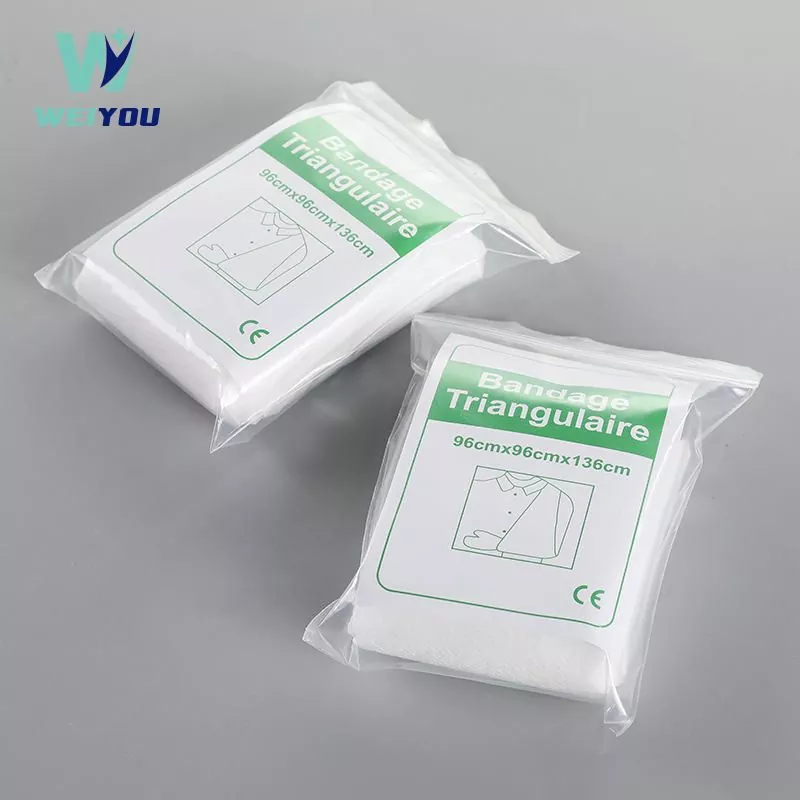- English
- Español
- Português
- русский
- Français
- 日本語
- Deutsch
- tiếng Việt
- Italiano
- Nederlands
- ภาษาไทย
- Polski
- 한국어
- Svenska
- magyar
- Malay
- বাংলা ভাষার
- Dansk
- Suomi
- हिन्दी
- Pilipino
- Türkçe
- Gaeilge
- العربية
- Indonesia
- Norsk
- تمل
- český
- ελληνικά
- український
- Javanese
- فارسی
- தமிழ்
- తెలుగు
- नेपाली
- Burmese
- български
- ລາວ
- Latine
- Қазақша
- Euskal
- Azərbaycan
- Slovenský jazyk
- Македонски
- Lietuvos
- Eesti Keel
- Română
- Slovenski
- मराठी
- Srpski језик
Are there any special precautions I should take when using adhesive bandages on sensitive skin?
2024-10-14

What are the different types of adhesive bandages?
There are several types of adhesive bandages available in the market today, each designed to cater to specific needs. The most common type of adhesive bandage is the standard strip, which is long and narrow and can be cut to size depending on the wound's location. Another type is the knuckle bandage, which is designed to fit the shape of the knuckle correctly. A fingertip bandage is similar to the knuckle bandage but is designed for the fingers. Some other types of adhesive bandages include butterfly bandages, which are used to close deep cuts, and blister bandages, which are designed to prevent blisters from forming.Are there any special precautions to take while using adhesive bandages on sensitive skin?
Yes, there are some precautions that people with sensitive skin should take while using adhesive bandages. Firstly, they should avoid using bandages with latex adhesives as these may cause an allergic reaction. They should instead opt for hypoallergenic adhesive bandages that are designed to be gentler on the skin. They should also ensure that the wound is clean and dry before applying the bandage to avoid any further irritation.How long can I leave an adhesive bandage on?
It is recommended to change the adhesive bandage every 24 hours or as recommended by a doctor. Leaving the bandage on for extended periods may lead to skin irritation or even an infection. However, it is essential to keep the wound covered to avoid any bacteria from entering the wound.Can adhesive bandages be used on children?
Yes, adhesive bandages can be used on children. It is recommended that parents use bandages that are designed specifically for children, featuring fun shapes and colorful patterns to distract them from the pain or discomfort. Parents should also ensure that the bandage is not applied too tightly or too loosely, which may cause further irritation.Overall, adhesive bandages are an essential item in any first aid kit and can be used to cover and protect cuts, scrapes, and other minor injuries. It is vital to follow proper hygiene practices when applying adhesive bandages, especially on sensitive skin.
Ningbo Weiyou Import & Export Co., Ltd. is a leading supplier of high-quality adhesive bandages and other first aid products. Our products are designed to cater to the specific needs of our customers, and we ensure that our products are manufactured using the highest quality standards. Please visit our website https://www.zjweiyou.com for more information about our products. For any queries or inquiries, please feel free to contact us at dario@nbweiyou.com.
10 Scientific Research on Adhesive Bandages
1. El Sayed, K., Sultana, F., & Ramadan, W. (2020). Therapeutic evaluation of occlusive versus conventional dressing on healing of skin-grafted burn wounds. Journal of Wound Care, 29(Sup7), S4-S9.
2. Jansson, J., & Ågren, M. S. (2020). The effect of occlusive dressings on skin graft healing in burn care: a systematic literature review. Burns, 46(2), 219-226.
3. Bhattacharya, V., & Pershad, Y. (2020). Comparative study to evaluate the effectiveness of hydrocolloid dressings versus conventional wound dressings for the management of diabetic foot ulcers. International Journal of Recent Scientific Research, 11(05), 37025-37028.
4. Abdul Razek, Y. A., Ali, M. E., EL-Rehim, A. A., & EL-Shahawy, M. A. (2019). Wound Healing Properties of Chitosan-Incorporated Polyacrylonitrile Nanofibrous Scaffolds. Advanced Materials Science, 49(1), 84-92.
5. Huang, J., Zhuo, Y., Duan, L., Zhao, L., Li, X., & Cui, W. (2019). Multifunctional wound dressings with antibacterial and osteogenesis-promoting properties prepared by in situ growth of hydroxyapatite on bacterial cellulose. Nanomaterials, 9(1), 45.
6. Money, S. R., Newby, L. K., & Raju, S. G. (2019). A comparison of polyester and polyurethane vascular access dressings. Journal of Vascular Nursing, 37(4), 254-261.
7. Stricker-Krongrad, A., Fischer, L. J., Bozzoli, A., Kanmanthareddy, A., & Helfenbein, E. D. (2019). Medical adhesives and dressings for negative pressure wound therapy in the modern treatment of chronic wounds. US Neurology, 15(2), 58-62.
8. Siddiqui, S. N., & Zafar, M. S. (2018). Occlusive versus open dressings in the management of postoperative wound infections. Journal of Ayub Medical College Abbottabad, 30(1), 1-5.
9. Clayton, N. A., Donnelly, B. J., Phillips, L. G., Mackay, D. R., & Morykwas, M. J. (2017). A pressure sore dressing that monitors the healing process. Journal of Biomedical Materials Research Part B: Applied Biomaterials, 105(7), 1761-1766.
10. Nemirschițchi, A., Droc, G., Stănescu, U. C., Oprea, D., & Jecan, C. C. (2016). Comparative study on the properties of silver alginate dressing and Stimulen collagen dressings. Wound Medicine, 15, 1-9.



